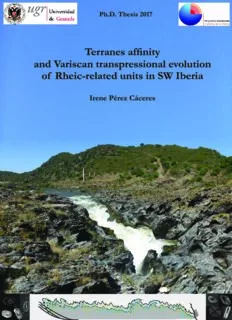
Terranes affinity and Variscan transpressional evolution of Rheic-related units in SW Iberia PDF
Preview Terranes affinity and Variscan transpressional evolution of Rheic-related units in SW Iberia
s Ph.D. Thesis 2017 e Ph.D. Thesis 2017 r e c á C z e r é P e Terranes affinity n e r I and Variscan transpressional evolution of Rheic-related units in SW Iberia Irene Pérez Cáceres n o i t u l o v e ala ni r oe ib s I s eW r pS s nn a i rs tt i nn au c sd ie r aat V l e dr n- c ai e yh t iR n fi f fo a s e n a r r e T Editor: Universidad de Granada. Tesis Doctorales Autora: Irene Pérez Cáceres ISBN: 978-84-9163-510-9 URI: http://hdl.handle.net/10481/48133 Departamento de Geodinámica Universidad de Granada Terranes affinity and Variscan transpressional evolution of Rheic-related units in SW Iberia Memoria de Tesis Doctoral presentada por la Licenciada en Geología Irene Pérez Cáceres para optar al Grado de Doctora por la Universidad de Granada. Granada, 23 de Febrero de 2017 Fdo. Irene Pérez Cáceres VºBº del Director Fdo. David Jesús Martínez Poyatos Foi nesta altura que, em profusão e diversidade internacional, apareceram os geólogos. (…) agora chegavam em força os sábios da terra e das terras, os averiguadores de movimentos e acidentes, estratos e blocos erráticos, de martelinho na mão, batendo em tudo quanto fosse pedra ou pedra parecesse. JOSÉ SARAMAGO A jangada de pedra Index Page Agradecimientos v Abstract ix Resumen xi Chapter I: Introduction 1 1. Geographic location 2 2. The Iberian Massif in the context of the Variscides 2 2.1. The Variscan belt 2 2.2. The Iberian Massif 4 3. Southwest Iberia 7 3.1. Southern Central Iberian Zone 8 3.2. The CIZ/OMZ boundary: The Badajoz-Córdoba Shear Zone 11 3.3. The Ossa-Morena Zone 12 3.4. The South Portuguese Zone 14 3.5. The boundary between the Ossa-Morena and South Portuguese Zones 16 3.5.1. The Cubito-Moura unit 17 3.5.2. The Beja-Acebuches Amphibolite unit 18 3.5.3. The Pulo do Lobo unit 19 5. Aims and structure of the Ph.D. Thesis 20 6. Methodologies 20 References 21 Chapter II: Pre-Variscan paleogeography of SW Iberian terranes 35 1. Introduction 38 2. Geological setting 41 2.1. Tectono-stratigraphic framewor k of the South Portuguese Zone 42 2.2. The Moroccan Variscides 43 3. Samples and methods 44 4. Results 45 4.1. Ribeira de Limas formation 45 4.2. Horta da Torre formation 46 4.3. Santa Iría formation 47 i 4.4. Ronquillo formation 47 4.5. PQ formation 48 4.6. Sehoul Cambrian metasandstones 49 5. Interpretation of detrital zircon populations 49 5.1. Ribeira de Limas formation 49 5.2. Horta da Torre formation 51 5.3. Santa Iría formation 51 5.4. Ronquillo formation 52 5.5. PQ formation 52 5.6. Sehoul Cambrian metasandstones 52 6. Discussion 52 6.1. Paleogeography and tectonic significance of the South Portuguese Zone 52 6.1.1. The basement of the South Portuguese Zone 53 6.1.2. The outcropping sedimentary cover 53 6.1.3. The Sehoul Block in northern Morocco 55 6.2. Cadomian/Pan-African tectonic frame of SW Iberia 55 7. Conclusions 59 Acknowledgments 61 References 61 Chapter III: Structure of the Ossa-Morena/South-Portuguese 71 boundary 1. Introduction 74 2. Geological setting 74 3. The Rheic Ocean suture in the Iberian Variscides 76 4. Orogenic events preceding Carboniferous collision 78 4.1. Closing of the Rheic Ocean and Late Devonian collision 78 4.2. Intraorogenic extensional stage 79 5. Carboniferous transpressional collision 80 5.1. Deformation at the southernmost Ossa-Morena Zone 80 5.2. Deformation of the Beja-Acebuches unit 81 5.2.1. Ductile shearing 81 5.2.2. Folds 83 5.2.3. Age of the deformation 84 5.3. Deformation of the Pulo do Lobo unit 85 ii
Description: